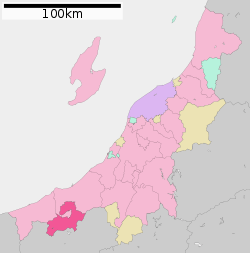Myōkō, Niigata
| Myōkō 妙高市 | |||
|---|---|---|---|
| City | |||
|
Myōkō City Hall | |||
| |||
 Location of Myōkō in Niigata | |||
 Myōkō
| |||
| Coordinates: 37°1′30.7″N 138°15′12.7″E / 37.025194°N 138.253528°ECoordinates: 37°1′30.7″N 138°15′12.7″E / 37.025194°N 138.253528°E | |||
| Country | Japan | ||
| Region | Chūbu (Kōshin'etsu) (Hokuriku) | ||
| Prefecture | NIigata | ||
| Area | |||
| • Total | 445.63 km2 (172.06 sq mi) | ||
| Population (June 2016) | |||
| • Total | 32,829 | ||
| • Density | 73.7/km2 (191/sq mi) | ||
| Time zone | Japan Standard Time (UTC+9) | ||
| Symbols | |||
| • Tree | Fagus crenata | ||
| • Flower | Glaucidium palmatum | ||
| • Bird | Blue-and-white flycatcher | ||
| Phone number | 0255-72-5111 | ||
| Address | 5-1 Sakaemachi, Myoko-shi, Niigata-ken 944-8686 | ||
| Website |
www | ||

Myōkō (妙高市 Myōkō-shi) is a city located in south-central Niigata Prefecture, in the Hokuriku region of Japan. As of 1 June 2016, the city had an estimated population of 32,829 and a population density of 73.7 persons per km². Its total area was 445.63 square kilometres (172.06 sq mi).
Geography
Myōkō is located in an inland region of north-central Niigata Prefecture, on the border of Nagano Prefecture. It lies in mountain surroundings near the historical entrance to the Echigo Plains. The city is surrounded by five mountains. Madarao, Myōkō, Kurohime, Togakushi and Iizuna are collectively known as the Five Peaks of Northern Shinano (Hokushingogaku). They make up the border of Nagano and Niigata Prefectures. As the city name implies, Mount Myōkō (2,454 metres (8,051 feet) ) is in the city, much of which is within the borders of the Myōkō-Togakushi Renzan National Park.
Surrounding municipalities
Climate
| Climate data for Sekiyama | |||||||||||||
|---|---|---|---|---|---|---|---|---|---|---|---|---|---|
| Month | Jan | Feb | Mar | Apr | May | Jun | Jul | Aug | Sep | Oct | Nov | Dec | Year |
| Average high °C (°F) | 3.3 (37.9) |
3.6 (38.5) |
7.4 (45.3) |
15.2 (59.4) |
20.5 (68.9) |
23.4 (74.1) |
27.0 (80.6) |
28.9 (84) |
24.4 (75.9) |
18.7 (65.7) |
12.8 (55) |
6.8 (44.2) |
16 (60.79) |
| Average low °C (°F) | −2.9 (26.8) |
−3.1 (26.4) |
−0.5 (31.1) |
5.1 (41.2) |
10.7 (51.3) |
15.6 (60.1) |
19.7 (67.5) |
21.1 (70) |
16.8 (62.2) |
10.5 (50.9) |
4.6 (40.3) |
−0.1 (31.8) |
8.12 (46.63) |
| Average precipitation mm (inches) | 325.1 (12.799) |
209.7 (8.256) |
135.8 (5.346) |
69.7 (2.744) |
88.7 (3.492) |
133.2 (5.244) |
188.1 (7.406) |
135.8 (5.346) |
168.7 (6.642) |
136.7 (5.382) |
150.9 (5.941) |
253.2 (9.969) |
1,995.6 (78.567) |
| Average snowfall cm (inches) | 422 (166.1) |
319 (125.6) |
175 (68.9) |
25 (9.8) |
0 (0) |
0 (0) |
0 (0) |
0 (0) |
0 (0) |
0 (0) |
15 (5.9) |
229 (90.2) |
1,185 (466.5) |
| Mean monthly sunshine hours | 74.5 | 87.9 | 118.6 | 167.1 | 175.8 | 126.1 | 123.0 | 156.5 | 107.8 | 117.6 | 105.7 | 84.2 | 1,444.8 |
| Source: 気象庁 Japan Meteorological Agency | |||||||||||||
History
The area of present-day Myōkō was part of ancient Echigo Province. The modern city of Myōkō was established on April 1, 2005, from the merger of the city of Arai and the town of Myōkōkōgen, and the village of Myōkō (both from Nakakubiki District)
Education
Myōkō has ten public elementary schools and four public middle schools. There is one public high school, and also one special education school.
Transportation
Railway
- Echigo Tokimeki Railway – Myōkō Haneuma Line
- Myōkō-Kōgen - Sekiyama - Nihongi - Arai - Kita-Arai
- Shinano Railway - Kita-Shinano Line
Highway
Local attractions
Myōkōkōgen and the former village of Myōkō are famed for their ski resorts. The first of these, Akakura, was founded in the 1930s, making it one of the oldest established ski areas in the world. It is also a traditional mountain retreat of Japan's imperial family. The Myōkō Ski Area has nine main mountain resorts: Myōkō Akakura, Ikenotaira Onsen, Myōkō Suginohara (which boasts the longest ski run in Japan), Seki Onsen, Kyukamura, Myōkō Ski Park, APA resort Myōkō Pine Valley, Madarao Kogen and Tangram Ski Circus.[1]
Myōkō Kōgen is also well known for its many local onsen (hot springs) emanating from the Jigoku-dani valley between Mts. Myōkō and Mae.[2]
International relations
Twin towns — Sister cities
Myōkō is twinned with:
References
External links
| Wikimedia Commons has media related to Myoko, Niigata. |
- Official website (in Japanese)
- The English-language website of the Myoko Tourist Office (covering the ski resort and hot spring areas of the city)
- Explore the Heart of Japan (English tourism guide for the area)
